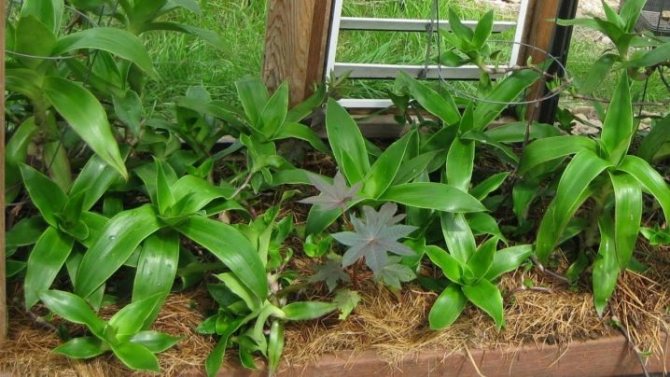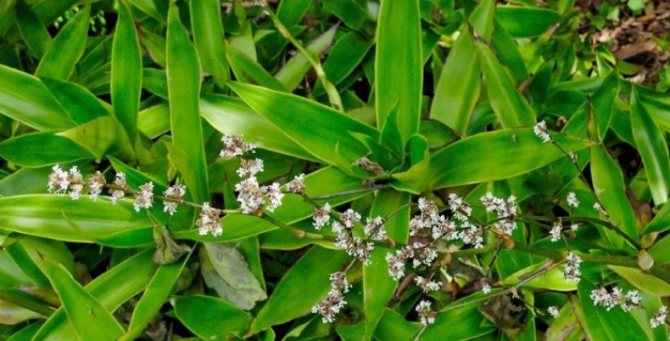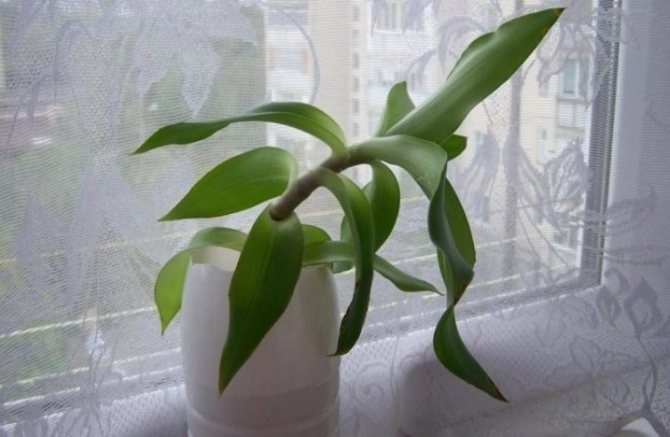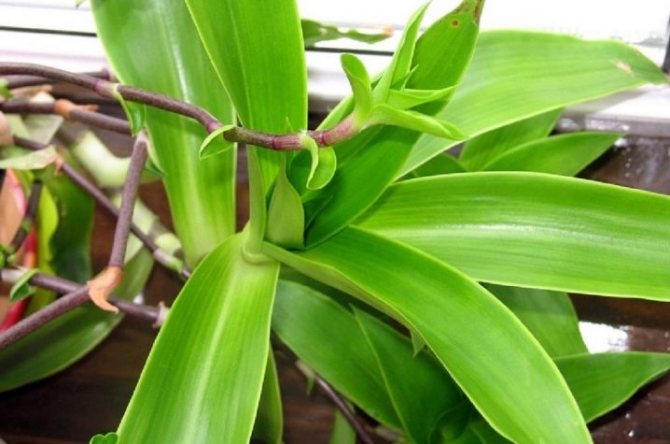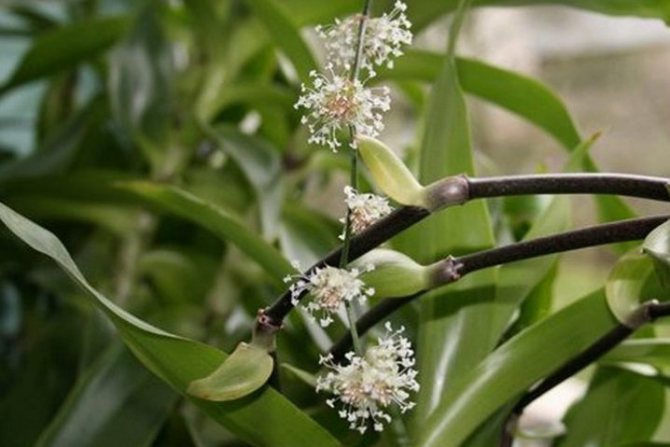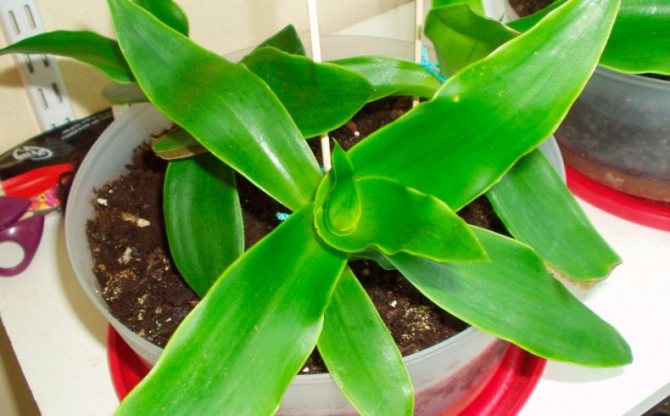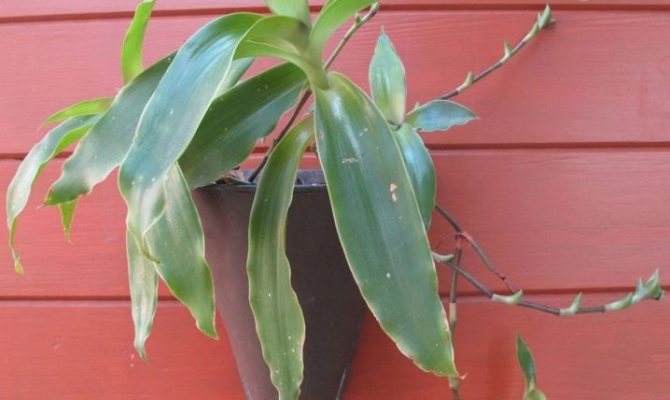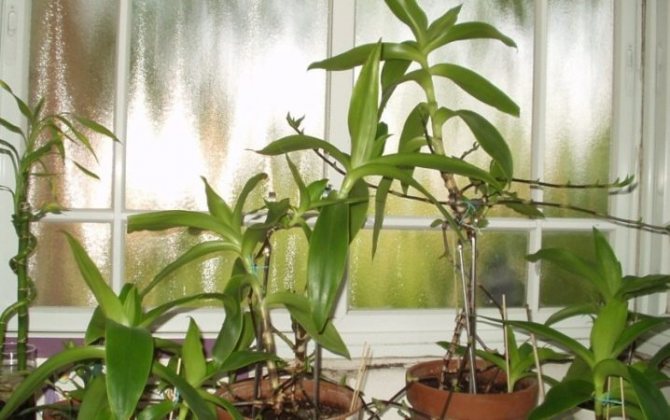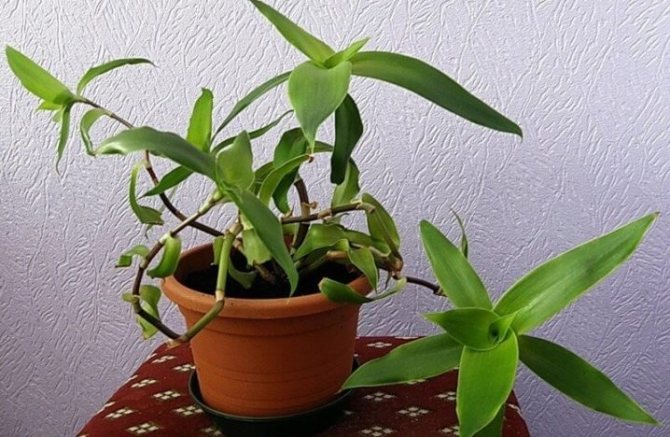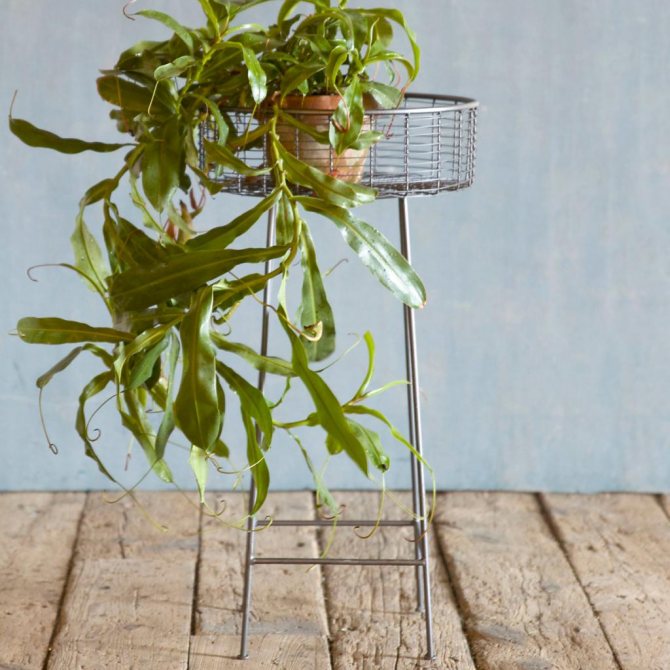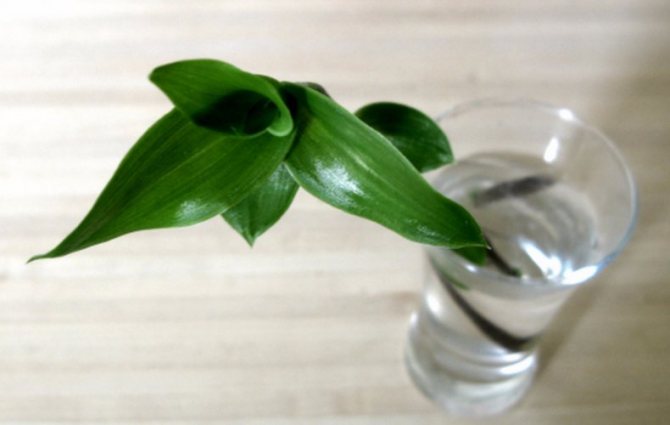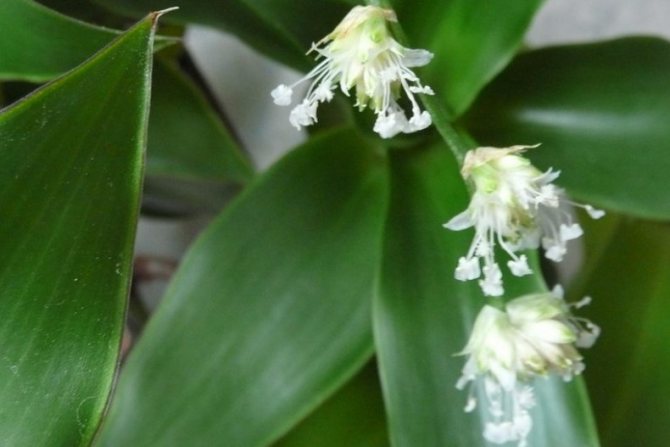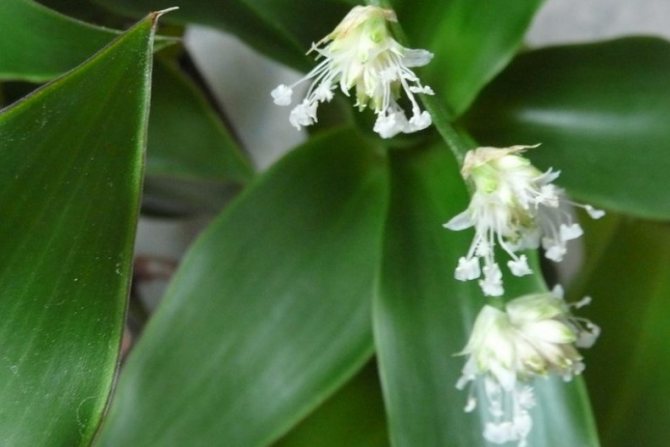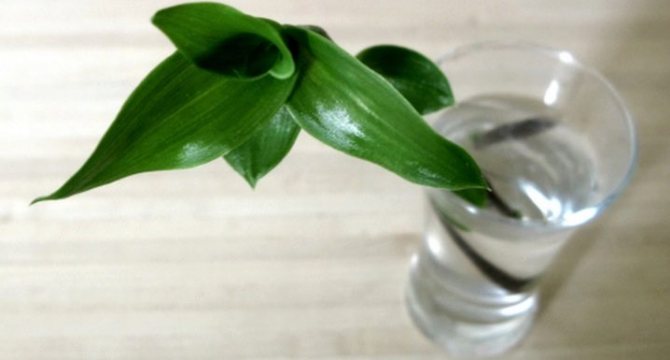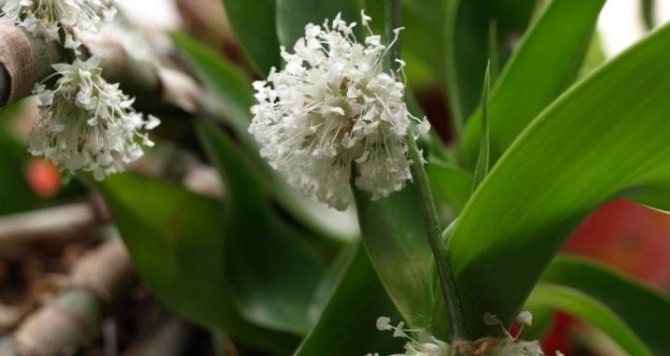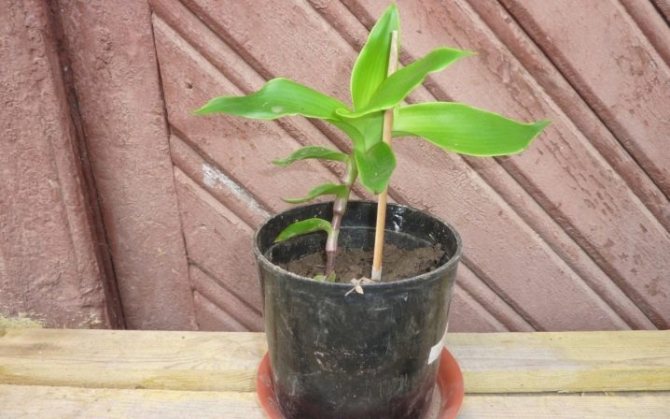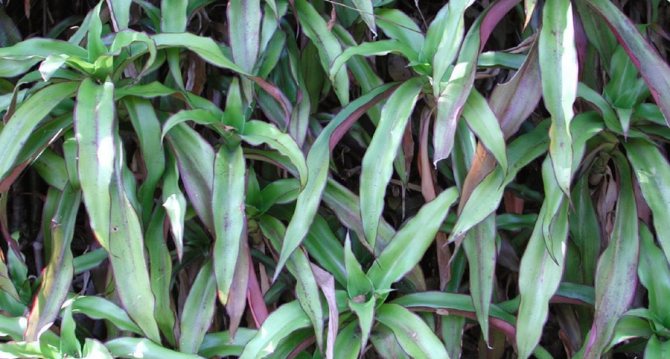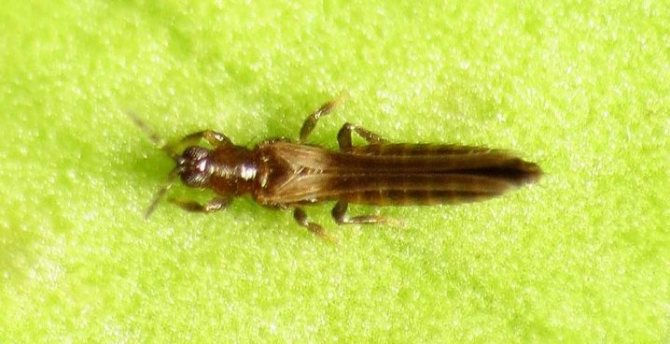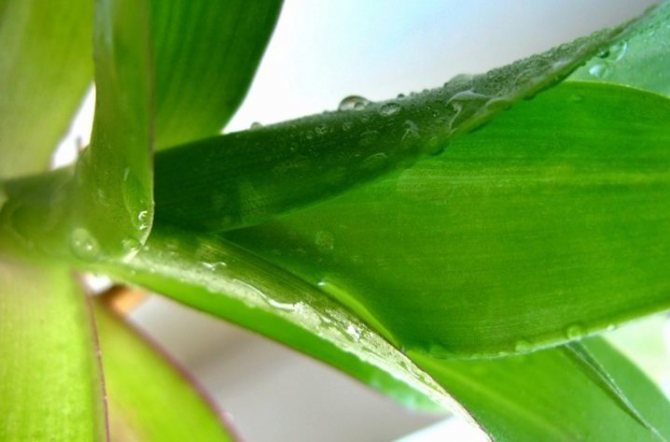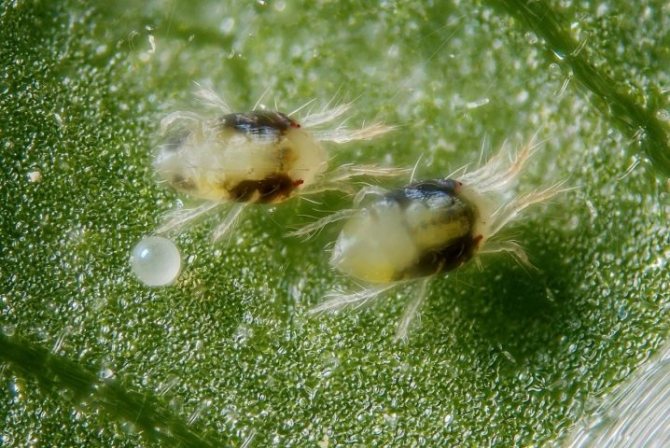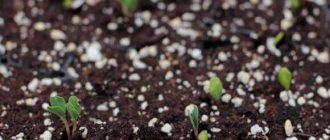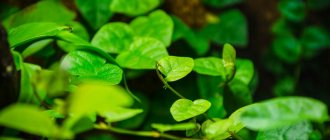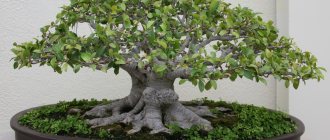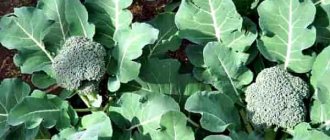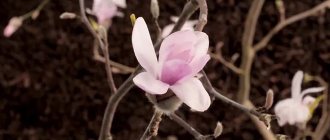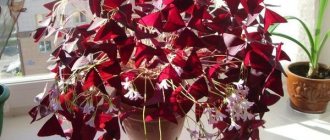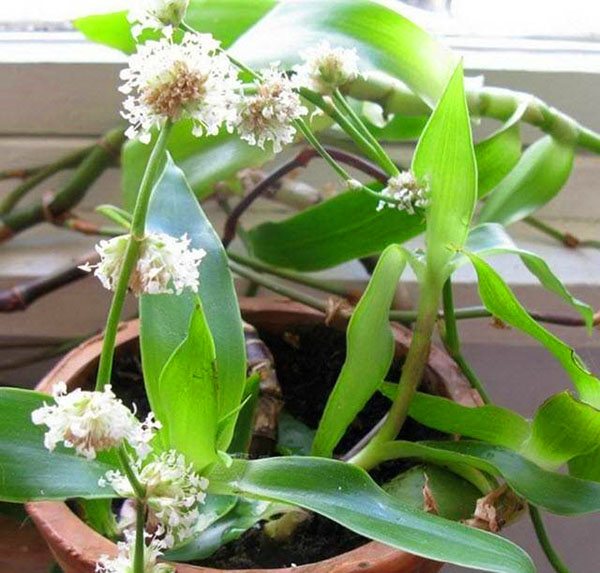
Among indoor plants that have medicinal properties, there is a golden mustache; growing this flower at home will not be difficult. The main thing is to adhere to certain recommendations and you will always have a source of medicines on your windowsill that can be used for a number of ailments. This is due to the chemical composition of this plant.
Its leaves and shoots, saturated with flavonoids and phytosterols, have beneficial qualities. It is these biologically active substances that are used for the preparation of medicinal products. Having on hand a tincture or a decoction of fragrant callis, as it is also called, can eliminate skin rashes, relieve rheumatism and a number of other diseases.
If you are planting a plant in order to use medicinal properties, then it is recommended that you first test for the occurrence of allergic reactions. This will avoid unpleasant consequences.
Description of the plant with photos
The golden mustache in the wild is a creeping perennial, reaching a height of 1-2 meters, outwardly resembling a liana. In indoor conditions, the growth of a golden mustache is very slow, and its height is limited to 30-40 centimeters. At the same time, the width of the plant increases to one and a half meters.
During growth, the golden mustache forms shoots of two types: straight and lateral. Shoots are covered with elongated, pale green leaves. At the ends of the shoots, flower rosettes of white or pink-white color with a pleasant aroma are formed.
Botanical description
Golden mustache, or fragrant callisia, - a slow-growing perennial, reaching about 1 m in height and 60-120 cm in width, with leaves 15-25 cm, arranged in turn. During growth, bulges form on the trunk, gradually transforming into separate shoots - "whiskers". At the same time, they include several "joints", at the end of which leaf rosettes are located. Such shoots belong to the first type and are used for reproduction as soon as the "whiskers" acquire a lilac color.
The second type is formed by straight fleshy leaves, similar to corn leaves. Their bases are close to each other, which is why there is often a misconception that this is one outlet. If you break the leaf, you can see thin stretching hairs, which became the reason for the appearance of such popular names for this plant as "hair Venus" or "living hair".
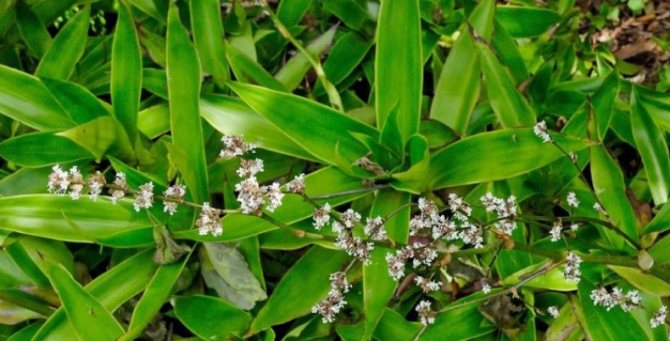

Required conditions for growing a golden mustache
Caring for a golden mustache plant, when creating the necessary conditions for it, is quite simple. You can place it in an apartment, greenhouse, greenhouse, and also keep it outdoors in the summer. The only contraindication is keeping the plant in the kitchen. Gas pollution and smoky air will negatively affect the condition of the plant.
Temperature and lighting
Golden mustache is a heat-loving plant. The ideal temperature for growing it is 25-28 degrees. In winter - at least 16-17 degrees.
The golden whisker plant loves good lighting, but does not tolerate direct sunlight.
The plant needs good lighting, but no direct sunlight. The light should be diffused. Then the color of the leaves will be deep green with a purple tint on the underside of the leaf plate.When the plant is kept in direct sunlight, its leaves acquire a distinct purple-purple hue.
It is recommended to grow golden mustache on east or west windows. If the windows of the apartment face south, you cannot keep a flower on the windowsill. Installation on the north window is absolutely contraindicated for the golden mustache: the plant will suffer from a lack of sun and will stop growing up. On cloudy days, the lack of light is compensated for with special phytolamps installed above the plant. The backlight is turned on for 3-4 hours a day.
Important. In winter, the golden mustache can suffer from the cold air coming from the frosty glass. Some growers note that when the plant is located on the windowsill in winter, brown spots appear on the leaves.
Care after purchase
Transplanting and caring for a golden whisker begins immediately after purchasing it in retail outlets. The plant must be transplanted into a larger pot with fresh soil added. But the procedure should not be carried out immediately after purchase, but after 7-8 days, when the plant adapts to new conditions of detention.
To prevent damage to the root system, the golden mustache is taken out of the old pot along with an earthen lump, placed in a larger pot and sprinkled with fresh substrate. If there are signs of soil acidification in the old pot, it must be cleaned off the roots and completely replaced. The decayed parts of the roots must be cut off, the healthy part must be treated with a weak solution of potassium permanganate.
After purchase, the golden mustache is transplanted into a spacious pot.
How it is propagated
First of all - with the help of those very mustaches. If you propagated strawberries in this way, then you will cope with callisia.
The easiest way in the summer is to plant a golden mustache on a flower bed or garden bed, and he will do everything for you: let go of the antennae, feel the soil and safely root its processes in several places.
You will remain closer to autumn, replanting the plant again in a room pot, just separate the young callisia and plant them in separate vessels.
The second way is by cuttings. For this, again, the antennae serve. They are separated, placed in a glass of water, or planted in poured light soil. Keep the cutting in a light (scattered), and when the roots go, plant in a deep pot.
When planting, deepen the cutting, so much so that about 3 cm remains between the leaves on its "crown" and the ground.
And the third way of reproduction is seeds. They can even be collected from your own plant, they can be stored for about six months in a paper bag. The main thing is to keep them in a dry, dark place. True, I have not tested this method yet. It is considered difficult and lengthy.
Also, the plant needs to be transplanted from time to time. The ideal time is spring. How to do this, a woman who has been growing a golden mustache for a long time and who has managed to study all its whims will tell:
Golden mustache is an amazing Mexican plant known for its unique medicinal properties. In Russia, it first appeared in 1890, and this is only thanks to the botanist and geographer, the founder of the Batumi nature reserve - Andrei Krasnov.
This plant has many names, the most famous being live hair, corn and homemade ginseng. Recently, the golden mustache has been very popular, thanks to the fact that many have learned about its medicinal properties and the fact that the plant can be grown on a windowsill, while there is no need for special care.
The height of the stem reaches from 1 to 1.8 m, large bright emerald leaves are located on the fleshy main shoot in a spiral. When exposed to bright light, the leaves turn pinkish. Blooming at home is extremely rare, but if this happens, it becomes possible to enjoy the pleasant fragrant aroma of small flowers collected in a hanging panicle.
A golden mustache or callisia can be taken outside in the spring, you can even plant it in open ground, however, in this case, there should be no other plants around within a radius of 70 cm. This is due to the fact that callisia spreads its lateral shoots in all directions and, in contact with the soil, sprouts.
It is worth noting here that the golden whisker grows rather quickly, and young sprouts contribute to the rejuvenation of old plants. The geniculate shoots of the plant contain the greatest medicinal value, despite the fact that each part, with the exception of the roots, has medicinal properties.
Useful properties of the golden mustache and its use in traditional medicine
The medicinal effects of the plant are due to the content of biologically active substances (quercetin, phytosterol and kemeferol) in it. In addition, the composition contains chromium, iron and copper.
- The plant effectively copes with various infections, removes toxins, inhibits natural aging processes, normalizes metabolism, and also strengthens the immune system and the circulatory system.
- The plant is recommended for gallbladder problems and pathologies of the gastrointestinal tract.
- Golden mustache is the best remedy for people who suffer from allergies and asthma, as the plant is able to fight allergic reactions, preventing rashes and itching.
- Yes, what to say, if this amazing plant from Mexico was even used.
- It quickly renews the skin after wounds and burns. The unique composition of the plant is used to treat varicose veins, periodontal disease, periodontitis, mastopathy, lactostasis, liver problems, ischemia and even Parkinson's disease.
- The treatment and prophylactic course of living hair helps to cope with such ailments as hemorrhoids, anemia, rheumatism, anemia, osteochondrosis and vascular spasms.
- In the case of the appearance of infections transmitted during sexual intercourse, for example, ureaplasmosis, dysbiosis, mycoplasmosis, Trichomonas, treatment with a golden mustache will not interfere.
Depending on the medical prescriptions, different parts of the plant can be selected for treatment, which will be used to create the most unexpected medicinal mixtures. They can be used for the preparation of tinctures, ointments, decoctions, and, but recommendations for their use should be agreed with the attending physician.
Alcohol tincture
When preparing medicines from plant trunks, it must be borne in mind that it is in the trunk that a huge amount of active biological substances is contained. Therefore, the preparations that are prepared from the trunk of the golden mustache are used only for external use. So, for example, an alcoholic tincture of 5 joints and 500 ml of 70% medical alcohol is used for joint pain.
For alcoholic tincture, you need to take those plants on the whiskers of which at least 10 nodes have formed. It is then that the concentration of medicinal substances is maximum. To prepare the tincture, you will need 30-40 internodes and a liter of vodka. Cut the side shoots, pour vodka, and leave for 10-15 days in a dark room, the tincture needs to be shaken periodically. You need to filter the tincture when it has become dark lilac. Such a tincture is stored in a dark and cool room.
If a mustache tincture is chosen for treatment, then it must be taken intermittently. For example, after taking the tincture for three weeks, you need to take a week break. Experts recommend to cleanse the body with enterosorbents during the break.
Oil tincture
To prepare the oil tincture, you will need the following ingredients: leaves, shoots and stem of a golden mustache, as well as vegetable oil. Grind the leaves, shoots and stem with a blender into a gruel, and pour hot oil (1: 2). Infuse the oil tincture in a dark place for at least 10 days.
Expert opinion
Golden mustache refers to medicinal plants that have a complex effect on the human body. Confirmed its positive effect on the immune system, the possession of a general strengthening effect, there is evidence of the antitumor activity of this plant. However, medicinal products based on the golden mustache need to be used with some restrictions.
Alcohol tincture is used only as rubbing or compresses for the treatment of arthritis or arthrosis. Inside, such a medicine should not be used, since such a solution has a powerful nephrotoxic effect.
Infusion on water
Decoctions are prepared from all the green parts of the plant.
- Chop the leaves, send to a saucepan, add water. Bring the mixture to a boil over low heat, remove from heat and leave for 6 hours. Strain the finished broth, store in a dark container, preferably glass, always cool.
- To prepare this infusion, the joints of the plant are used, they will need from 20 to 30 pieces. The joints are filled with hot water and brought to a boil, after which the broth should be infused for 10 hours. The finished broth must be filtered and stored in a cool place in a glass container.
These infusions are suitable for both internal and external use.
100 g of broth inside 3 times a day can cope with stomach ulcers, diabetes mellitus, intestinal inflammation, pancreatitis.
For acne and various skin diseases, the decoction is applied externally: compresses and washing.
Do not forget that the medicinal properties of the plant are not fully understood at the moment and, it is rash to consider the golden mustache as a cure for all diseases, completely refusing drug treatment. When using it at home, always use caution, especially if this method of treatment is chosen for children.
Fragrant callis is the name of the golden mustache in scientific circles. This plant has medicinal properties not less than in scarlet and Kalanchoe. Unlike these plants, it has not been approved by the Ministry of Health, and discussions continue around it. But these discussions are overlooked by lovers of traditional medicine.
In traditional medicine recipes, the use of the golden mustache is quite wide. It is popularly called homemade ginseng. If you are concerned about such ailments as bronchial asthma, gastrointestinal tract, pulmonary diseases, gall bladder, spleen, then you can use this plant without worrying about the negative consequences. The people are of the opinion that with the help of this plant it is possible to alleviate various types of painful sensations. For example: relieve itching, healing burns, bruises, relieve lichen, ulcers. In order to use this plant for medicinal purposes, it is not necessary to buy it, you can also grow it at home.
Fragrant Callisia is a very large houseplant, reaches 1 m in height. Propagated by shoots, they resemble vines (whiskers). The mustache is made up of joints. They are purple-brown in color and have a broom of leaves at the end. A plant with nine or more joints on the shoots can be considered a medicinal plant.
Having planted a golden mustache at home, you need to remember that regardless of the fact that he loves warmth and light, he in no case does not accept direct sunlight.
Golden Mustache Transplant
A young plant needs replanting annually. The procedure is carried out in the spring, immediately after the end of the rest period. The golden mustache does not like when its roots are disturbed, therefore, the plant must be removed from the pot with the utmost care, trying to completely preserve the earthen lump.
You can gently free the roots from the old pot by placing it completely in a container of water for 1-2 minutes. In this case, the plant is easily removed from the pot, and it is immediately placed in a new planting container. The diameter of the new pot should be 3-4 centimeters larger than the previous one.A golden mustache, together with an earthen lump, is installed in a new pot and fresh soil is poured along the edges. After transplanting, the plant is watered abundantly and placed in a slightly shaded place.
A feature of the golden whisker is the loss of leaves on the lower part of the shoots as it grows. Timely pruning of shoots for medical use can prevent this problem.
The golden mustache needs to be regularly rejuvenated, that is, instead of transplanting an adult plant into a new pot, you can cut and root young leafy rosettes. For greater bushiness, 2-3 sockets can be planted in one pot. The procedure is recommended in early spring or early autumn.
The golden mustache plant is periodically transplanted into a larger pot.
Requirements for the composition of the soil
The plant needs a loose, nutritious soil, which you can prepare yourself, or purchase a ready-made substrate in a specialized store.
For self-preparation, you need three components:
Forest soil from under deciduous trees (except for birch). Well rotted humus. Coarse river sand.
All ingredients are mixed in equal parts. Alternatively, you can mix forest soil in half with purchased universal soil.
Important. All soil components are pre-disinfected with a strong solution of potassium permanganate. It is recommended to rinse the sand from particles of clay, and then ignite in a frying pan or in the oven.
Selection of containers for growing
The most suitable container for growing a golden mustache is a ceramic pot with a large drainage hole. The volume of the pot should be twice the size of the root system. The width and depth of the planting tank should be approximately the same.
You should not plant a golden mustache in plastic dishes, as in such a pot there is a risk of waterlogging the roots. In a wooden container, the soil will dry out too quickly, which is also harmful to the roots of the plant.
For growing a golden mustache, it is better to choose ceramic spacious pots.
Soil and nutrient dressings
Loamy soil with slightly acidic PH values is suitable for planting a golden mustache. The soil can be picked up in a specialized store. A universal one will work well. And it is best to prepare the potting mix yourself by mixing the following ingredients:
- Horse peat.
- Deciduous humus.
- River sand.
The soil should be light, nutritious. To prevent moisture from stagnating in the area of occurrence of the roots, 3-4 cm of any drainage material should be laid on the bottom of a wide pot. Ordinary expanded clay, eggshells or pieces of sphagnum will do. Before adding sand, it should be ignited or abundantly spilled with a pink solution of potassium permanganate for disinfection.
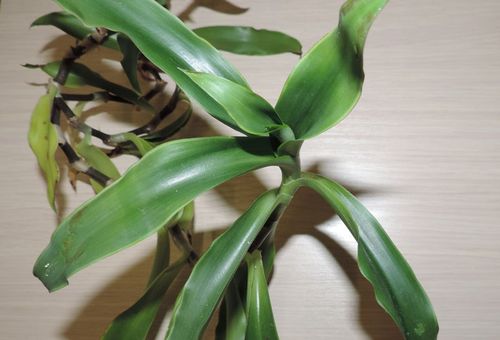

Important: do not forget that the soil collected by yourself under the trees can be inhabited by the larvae of harmful insects, which are deadly for the roots of the golden mustache. Hourly roasting in the oven will help solve this problem.
Over time, the soil in the flower pot is depleted and the plant slows down. The golden mustache needs regular nutritional supplements. He responds well to the introduction of organic fertilizers, but this is not always appropriate in an apartment. Therefore, the owners pamper their pets with complex feeding. The main thing is that they contain nitrogen, phosphorus and potassium. In winter, it is not required to apply fertilizers more than once a month, and when the golden mustache starts to grow in spring, the amount of fertilizing needs to be increased to once a week.
Plant care at home
For normal growth and maintaining the health of the golden mustache, it needs to provide conditions close to living in its natural environment. A tropical plant is sensitive to soil and air moisture, as well as to light levels. Plant care consists of watering, fertilizing and replanting.
Watering and spraying rules
The golden mustache is picky about the level of soil moisture. The soil should be constantly slightly damp. But moisture stagnation must not be allowed, therefore, there must be high-quality drainage at the bottom of the tank.
The plant must be watered abundantly, evenly moistening the entire clod of earth. Excess moisture from the pallet must be drained. Watering the golden mustache is recommended in the morning. In winter, watering is reduced, but it is impossible to overdry the soil. The need to moisten the soil in the pot is determined by the sound when knocking on the edges of the dishes. If the sound is ringing, then the earth is dry. A dull sound indicates soil moisture.
For irrigation, settled water at room temperature with slight acidification is used (a tablespoon of lemon juice or a teaspoon of citric acid per liter of water).
The leaves of the golden mustache are periodically sprayed.
The humidity in the room where the golden mustache is contained should not fall below 60%. Dry air leads to yellowing of the leaves. To maintain moisture, the plant needs to be sprayed regularly. This procedure is especially relevant in winter, when the air is dry from operating radiators. In winter, it is advisable to place an artificial fountain next to the plant, or put the pot on a pallet with expanded clay filled with water.
Spraying should not be done with plain tap water, which contains admixtures of lime and chlorine and leaves white streaks on the leaves. For irrigation of plants, melt water is used, previously frozen in the refrigerator, and then thawed and warmed up to room temperature.
Important. The humidity of the air for the golden mustache is much more important than the humidity of the soil, since it is precisely to such conditions that the plant is accustomed in the wild.
Necessary feeding
Organic dressings are most effective for fertilizing the golden mustache. When transplanting, peat or humus is necessarily added to the substrate, as the main sources of nitrogen. An alternative nitrogen source is ammonium nitrate, which can be used to water the plant every 2-3 weeks.
The plant also needs phosphorus and potassium. To prepare the nutrient solution, you need to take 1.5 teaspoons of superphosphate and 0.5 teaspoon of potassium salt, dissolve them in 5 liters of water. Top dressing of the golden mustache with such fertilizer is carried out during the entire vegetative period every 2 weeks by watering at the root. In winter, the plant does not need feeding.
The golden mustache needs periodic feeding.
Tying a plant
For the shoots of the golden mustache, it is recommended to install special ladders or props in the pot, and then tie the flower stems to them. Alternatively, you can spread the shoots of the plant on the windowsill, in which case a garter is not required. There is no need to tie up shoots when growing a golden mustache as an ampelous plant in a hanging planter.
Secrets of proper care
A visitor from the tropics is sensitive to lack of sunlight. If the pot with the golden whisker is in shade, you should be ready to pull out the shoots. The stems and leaves will fade, and flowering is out of the question. The plant feels great on the windowsills located on the east side. The south side is also suitable for a golden mustache, but when leaving, you will need to shade the flower.
The humid climate of the historical homeland made the plant demanding for high air humidity. In the morning and in the evening, you need to spray the golden mustache with soft, settled water using a spray bottle. The pot can be placed on a pallet with small pebbles and water can be poured - this way you can do without constantly wetting the stem and leaves.
Important: when carrying out weekly cleaning, do not forget about the leaves of the golden mustache. Wipe them with a damp cloth and remove accumulated dust.
Immediately after purchasing a seedling, you need to adjust the watering. Complete drying out of the earthen coma is unacceptable: a golden mustache may not recover from the stress it has endured.You can water the flower according to the following scheme:
- from mid-spring to early autumn - 3-4 times a week;
- with the onset of a cold snap - once a week.
The golden mustache likes it when the owner acidifies the water when watering. You can do this at home with a few grains of citric acid or a couple of drops of fresh lemon juice. Proper care consists in loosening the soil under the plant weekly. This must be done carefully, trying not to damage the delicate roots.
Breeding methods
Golden mustache is propagated by sowing seeds and vegetative methods.
Seed propagation
Getting a plant from seeds is a long and unreliable method of reproduction. The main problem is getting seeds. The plant blooms extremely rarely and practically does not form seeds. Reproduction of golden whiskers by seeds is mainly used by professional breeders.
Vegetative breeding methods
Vegetative propagation methods include rooting shoots (cuttings) or rosettes of leaves:
Rooting of shoots (whiskers or cuttings). For reproduction with a mustache, take a shoot, remove the leaves from the bottom and immerse the workpiece in a glass of water for two weeks. As soon as the shoot gives roots, it is placed in a container with soil. The shoot is placed in the soil up to the first leaves, for the formation of new roots. Reproduction by cuttings is from March to April.
The mustache or cuttings of the golden mustache root well.
Rooting rosettes with leaves. Leafy rosettes are formed at the tops of the shoots. They are separated from the shoot with a sharp knife, leaving a part of the stem base on the rosette. The cut outlet is placed in a container filled with water. The fluid must be changed every 2 days. The roots, as in the first case, are formed in 14-15 days.
Dividing a bush (or growing a plant from a rooted layer). The shoots of the golden whisker often tilt and take root on their own. By separating such a rooted and overgrown rosette, you can get a new plant specimen.
What you need to know about the reproduction of fragrant callis?
After the golden whisker has finished blooming, tiny seeds can be collected and sown. But at home, bud formation is extremely rare, so this method is not common among breeders. The plant propagates easily in the following ways:
- Layering using an adult specimen.
- Cuttings rooted under the film.
- Rosettes rooted in distilled water.
When growing a golden whisker in the greenhouse, the method of rooting long shoots is used. "Whiskers" of an adult plant are sprinkled with earth and watered abundantly. In two weeks, roots will appear on the shoot. Now you should carefully separate the rooted part of the flower and plant it in a permanent place.


Cuttings are obtained from a shoot, which is cut into pieces so that each piece contains 3-4 internodes. They are planted in a prepared soil mixture of peat and sand; with the help of a film, the containers for growing are covered and left at room temperature in a bright place. Rooting will occur in a couple of weeks.
Important: the cuttings must be watered as the soil dries, and the greenhouse must be ventilated daily and the accumulated condensate removed.
The golden mustache forms many rosettes at the ends of the shoots, which can be used for breeding at home. Healthy large rosettes with short stems root perfectly in a glass of water. The water needs to be changed periodically to avoid stem decay. After the flower has grown a powerful root system, the seedlings are transplanted for further cultivation.
Disease and pest control
The most common pests affecting the plant are thrips and spider mites. They attack the golden mustache if the air in the room is too dry. It is necessary to fight insects with the help of systemic insecticides for indoor plants (Fufanon, Aktara, Iskra).
Mealybugs can attack the root system of the golden mustache.The larvae of these pests enter the planting containers along with the garden soil and, when waterlogged, begin to actively develop. The plant begins to lose leaf turgor, looks depressed.
As the insect multiplies, a white bloom appears on the leaves, similar to pieces of cotton wool. The mealy worm sucks the juices from the shoots and leaves or eats up the roots. When signs of damage to the golden mustache with mealybugs appear, the plant must be washed with soapy water, then sprayed with an insecticide (Confidant, Biotlin, Fitoverm, etc.).
Precautions
The well-known herbalist Natalya Zubitskaya (Earthly) warns: although the plant heals many problems, if you use it too much, it will strongly “hit” the pancreas.
Normal dose for health: three times a day, 1 drop of 10% tincture, or 3 wipes a day (treatment of joints).
This is elementary, but still: before starting to be treated with any herb, first consult a doctor, at least a phytotherapist. All organisms are individual, and it will be better if the dosage is prescribed by a specialist.
Sometimes this plant is confused with decharisandra. Here she is in the photo:
This is also a green healer. True, he no longer "specializes" in joints, but in throat ailments. Look at the leaves of the plant: they are smooth in the golden mustache, and fluffy in the deharizandra.
And the last thing: sometimes at home you can see this picture:
But, although a golden mustache is useful, do not let your furry pet destroy an entire flowerpot at once, or at least a whole leaf. A change in voice or even loss of voice can be a sign of overeating. If your kitty is suddenly hoarse, it means that she has already overeat. But a large piece of "delicacy" can also cause indigestion ...
Possible growing problems
With the correct selection of a place for growing and following the care recommendations, there are practically no problems with the plant.
If a golden mustache is exposed to the sun a lot, its leaves may turn yellow.
Violation of the recommendations can lead to the following phenomena:
Brown spots on the leaves and drying of the tips - lack of water or excess sunlight. This symptom may indicate a lack of nutrients in the soil. Rotting of the lower leaves - waterlogging of the soil or too low temperature of the content. Yellow, rust-like spots on the leaves - improper feeding, irregular watering (alternation of waterlogging and overdrying of an earthen coma). Mustaches do not form on the plant - lack of lighting. When growing a golden whisker in the shade or on northern windows, shoot growth stops, whiskers and new leaf rosettes are not formed.
Regardless of the cause of damage to leaves and shoots, the plant must be pruned. All stained leaves must be removed, since harmful substances accumulate in them.
Why does everyone grow it so actively
It's simple: because of the medicinal properties of the flowerpot. Many doctors simply sing the praises of the golden mustache, many books have been devoted to it, and there are so many videos on the Internet that cannot be counted at all.
Golden Mustache can heal:
- diseases "like a woman";
- joint problems;
- bowel disease (such as pancreatitis);
- skin problems (my sister has been making an alcoholic lotion for acne from the shoots of the plant for many years and is very happy with it);
- lower high blood sugar;
Also, the plant is included in anticancer drugs, body creams and many other pharmaceutical products.
Are you interested? You will learn a lot of recipes and how to use them from this video:
Benefits of Golden Mustache and Its Medical Uses
Golden mustache juice contains a large amount of biologically active substances. In terms of its healing power, this plant is similar to the famous ginseng root of life.
Attention. A plant that has formed at least 9 joints (nodes) on the shoots has healing properties.
In this video, you can learn more about the beneficial properties of the golden mustache and see how this plant is grown.
Golden mustache helps to get rid of many ailments:
Normalizes digestion, helps to activate the spleen. Possesses wound healing properties. It has a positive effect on the circulatory and respiratory systems. Helps with bruises, sprains, joint diseases. Heals calluses and frostbite. It has a general strengthening effect, increases immunity. It is used for thrombophlebitis, diabetes mellitus, stroke.
Decoctions, infusions are prepared from shoots, leaves and juice of a golden mustache, and used as components of an ointment.
Tips for planting and caring for a golden whisker
Home ș2 Healing herbs ș2 Golden mustache
The golden mustache plant, also known as fragrant callis, has found wide application in folk medicine. It is believed that its horizontal shoots have medicinal properties, the maturity of which is determined by the color of the internodes. They should take on a purple hue. As a houseplant, the golden mustache has been bred for more than a hundred years. Its medicinal properties have become known relatively recently.
Content:
Planting and care - general characteristics Air temperature Watering Lighting Planting at home Reproduction
Flower facts and description
South America is considered the homeland of this plant.
The culture was actively used in home floriculture back in the 19th century, when the culture was just discovered. Then the callisia was forgotten for a while.
Today, the golden mustache is also used for cultivation in room conditions... Not only as a decorative culture, but for its useful and medicinal properties.
The spread of the plant as a medicinal product was promoted by V.N. Ogarkov, who published an article on the healing properties of the golden mustache in 2000.
The central erect stem can grow up to 2 meters in height. Shoots or whiskers grow horizontally from the central stem. Small shoots grow at the ends of the lower shoots.
On the horizontal lower shoots, knots and knees are also formed, along which you can determine the age of the culture... The shade of the leaves depends on the amount of light.
They can be light or dark green or almost purple. On average, the leaves grow about 20 cm.
Golden mustache blooms extremely rarely, only with proper care. The flowers are small, they form inflorescences. Colors: white, pink.
Thus, the golden mustache is ornamental and medicinal plant, which has been used successfully to treat diseases. In care, he is unpretentious, but a number of rules for the content of this culture must be observed.
Planting and care - a general characteristic
Golden mustache is a perennial plant, growing very slowly. It blooms quite rarely and only with good care. It is extremely difficult to achieve flowering at home. In adulthood, it reaches more than a meter in height. To avoid fractures from the severity of the flower itself and shoots, the plant is tied to a support.
Air temperature
The flower loves warmth. The ideal temperature for him is 25-28 degrees. In winter, if the temperature drops to 16 degrees, it will be difficult to tolerate such conditions and will get sick. The disease manifests itself in the fact that the stems become thinner, become brittle, the leaves turn yellow and dry out. He also does not like sudden changes in temperature.
The golden mustache is most often grown as a houseplant, but is also planted outdoors. The use of organic fertilizers is mandatory when caring for a plant.
Important! Fertilizers should contain phosphorus and nitrogen. Golden mustache is fed weekly.
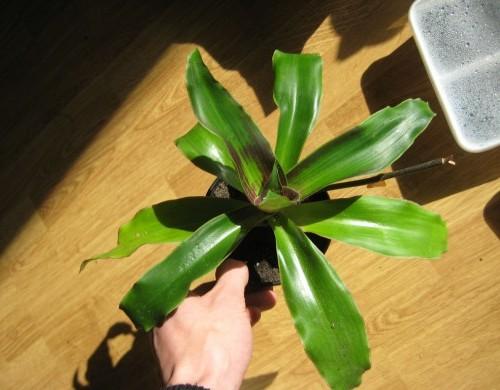

Watering
Watering with milk diluted in it (50 g of milk per liter of water) and rubbing the leaves with milk is considered useful for a flower.
The flower is watered in the morning. Drying out and at the same time shading of the soil should not be allowed. In winter, watering is reduced to twice a week.It is recommended that the soil be slightly dry in winter.
Important! Here you can read about the healing properties of golden mustache tincture.
The plant must be sprayed with water. This will help to avoid yellowing of the leaves and dropping.
Lighting
Callisia loves sunlight and partial shade. But you cannot put it under direct rays. In full light, the flower grows in breadth, being in the shade, stretches up.
If the plant is sick, the leaves wither, turn brown, you need to try to change the conditions: either put the flower in the shade, or take it out in the sun, but after midday sun and change the watering regime.
The plant is susceptible to spider mite damage. To combat it, the flower is sprayed with a special preparation and covered with polyethylene. Pest prevention - constant spraying and adherence to the humidity regime.
Recommended! Read more about the healing properties of the golden mustache here.
A visitor from the tropics: humble and graceful
Judging by the abundance of pots with a golden mustache on the windowsills, the plant originally existed on the territory of our country. But this is not at all the case - the homeland of the flower is the tropical forests of South America. In its native spaces, a golden mustache can grow up to 3 meters high, its shoots twine around tree trunks and fill the voids of rocky crevices. At home, with proper care, the shoots hanging from the pots grow up to 1.5-2 m in length.
Important: if a flower is planted for the sake of obtaining medicinal infusions, an allergic susceptibility test should be carried out in order to avoid disappointment after using the drug.
If not ampelous cultivation is practiced, then the stems need strong support. Here are the distinctive features of an exotic plant:
- leaves are alternate, narrow, up to 30 cm long;
- the outer side of the leaf is light green, the inner side is dark green with a burgundy tint;
- thin brownish shoots (whiskers) with internodes sprout from the leaf axils;
- rosettes of tiny leaves are located at the ends of internodes;
- small flowers consist of three petals of delicate lilac or pink color.


The genus Callisia from the Kommelinov family has more than 10 species; in our country, only one of them is cultivated. Golden mustache blooms extremely rarely, only among diligent breeders, for this process he needs optimal care conditions. But if it bloomed ... Even a small group of blossoming flowers can fill a room with a magical aroma with sweetish notes.
Planting at home
It is better to take a large flower pot right away. Golden mustache doesn't like transplants. In addition, its roots grow strongly and are easily damaged by replanting the flower.
The shoot of the golden mustache is planted deeper than the seedlings of other plants. Roots will sprout along the entire length of the stem when placed in water, so planting deep will provide better rooting and the plant will take root better.
Important! When planting, drainage is required (expanded clay, gravel stones).
Sand, turf and humus are added to the ground for planting in equal proportions. Ordinary soil from the garden will do. Only in this case, after planting, the plant must be fertilized.
We take care of the medicinal plant
In the warm season, more specifically in spring and summer, the flower should be watered every day. In this case, use a small amount of liquid. Waterlogging of the soil can negatively affect plants and their development. In autumn and winter, callisia should be watered 3 times a week. The most optimal temperature for the normal development of a plant is considered to be 26 ° C, humidity will be preferable - 55%. In winter, the period of calmness of most plants, the temperature regime in which the plant is contained is recommended to be reduced. After rooting, the flower is fed with liquid fertilizers. The leaves are sprayed with softened water every three days.
With good development and growth, callis should be attached to an additional support, because the plant can break under the weight of its weight and lateral processes.
It can be concluded that the golden mustache is not a very picky plant. It can easily grow and reproduce at home.
Reproduction
The golden mustache in its natural environment reproduces by lateral shoots. As they grow, they reach for the ground, take root in it and separate from the mother plant. This method can be used if callisia is grown in large pots, greenhouses, or outdoors. When the shoots descend to the ground, they are sprinkled with soil and cut off after a few days.
Recommended! Here you can learn how to properly plant and care for badan -
At home, the plant propagates by seeds or division (cuttings, shoots):
Cut off the top, consisting of 2-4 nodules, they are also called joints. The scion is placed in the input. Once it grows roots (usually after two weeks), it can be planted in the ground. The stalk can be planted in well-moistened soil already 2 hours after cutting. In this case, it is recommended to cover the top with polyethylene. Such a greenhouse will help to settle down better.
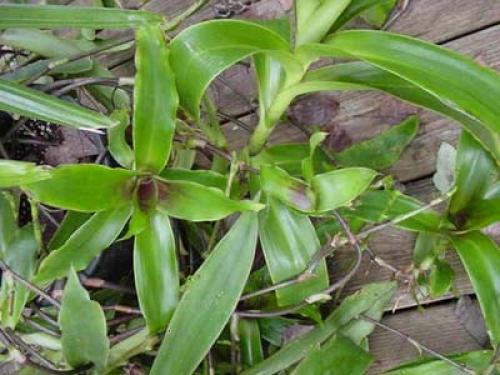

It is extremely difficult to collect seeds on your own, since the plant blooms very rarely, therefore division remains the most common and simple way of reproduction.
Important! By cutting off the cuttings from the top, the plant rejuvenates and does not stretch upwards.
You can plant a golden mustache all year round, but the most favorable time is March - April.
Scented Callisia, or Golden Mustache
The botanical name for the popular golden mustache is fragrant callis. It belongs to the Commelinaceae family. There are 12 species in the genus Callisia that grow in the tropics of Central and South America and Mexico. But in culture, only one species is best known - the fragrant callisia (Callisia fragrans). Fashion for it arose in the nineteenth century, immediately after the opening. Then Kalizia was almost completely forgotten, and now they began to breed not as an overseas curiosity, but as a medicinal plant (by the way, not only in our country, but also in the West).
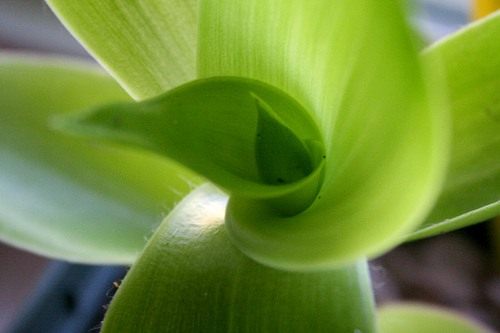

<>
In nature, this creeping grass up to 2 m long "crawls" along the mountain slopes and clearings, rooting in the nodes. It is named with a golden whisker because of the presence of long shoots that extend from the axils of the leaves, like the "whiskers" of strawberries, and take root in the same way. The length of these "whiskers" is up to 1 meter, they are naked, reddish-brown with long internodes and small rosettes of leaves at the ends (it is usually believed that only shoots no shorter than 9 internodes are suitable for treatment). Large, up to 30 cm, almost linear alternate leaves, covering the stem, develop only after rooting. When a sheet breaks, thin threads of rubber stretch between its parts. The stem of this plant, although long, is not able to stand upright, so it needs support in the apartment. Flowers, which rarely form in rooms, appear from the axils of the leaves and are collected in paired, hanging brushes on small peduncles. Each flower has three white, pink or blue petals, despite the fact that the inflorescences themselves are inconspicuous, they attract attention with a strong pleasant smell, similar to the smell of hyacinth.
This plant has changed its name several times. The first description was made in 1840 as Spironema fragrans, then it was renamed Rectanthera fragrans. The modern name - callisia (translated from the Greek. Καλός - beautiful, Λις - lily - "beautiful lily") she received only in 1942, from the American R. E. Woodson. In 1978, in Kiev, the book "Houseplants and Ornamental Flowering Shrubs" was published, in which they made an unfortunate mistake, calling Kalizia dichorizandra. Dichorisandra thirsiflora - dichorisandra brush-colored, although a close relative of callisia, but a completely different plant, moreover, very rarely found on windows.Other types of dichorizandra are much more common, but none of them, as far as we know, has a medicinal effect. In all species of dichorizandra, elliptical leaves (most of them are variegated) are arranged but spirals and create a beautiful rosette, it does not form a mustache or rubber threads.
Dichorizandras are much more capricious, they need humid air, some species and forms in rooms survive only under a hood that provides sufficient humidity.


<>
Vladimir Nikolaevich Ogarkov made a great contribution to the distribution of the golden mustache as a medicine, who had been using it in his practice for almost thirty years before the publication of the first article that appeared in the “Healthy Way of Life” newspaper in 2000. This was followed by a whole series of articles by other authors. With their light hand, kalizia is now widely used in folk medicine.
Scientific studies of the composition and action of the golden mustache are being carried out in St. Petersburg and Novosibirsk, and the only thing that has been fully proven so far is not the poisonousness of the plant. It actually contains a number of biologically active substances. And above all, it has a wound healing effect for scratches, cuts, minor burns. To do this, smear the sore spot with fresh juice or apply a crushed sheet to it.
For all more complex cases, the plant is preliminarily subjected to a special treatment, enhancing its activity. To do this, the stem and "whiskers" of calizia are wrapped in plastic wrap immediately after cutting and placed in the lower part of the refrigerator for two weeks at a temperature of about 3-4 degrees above zero.
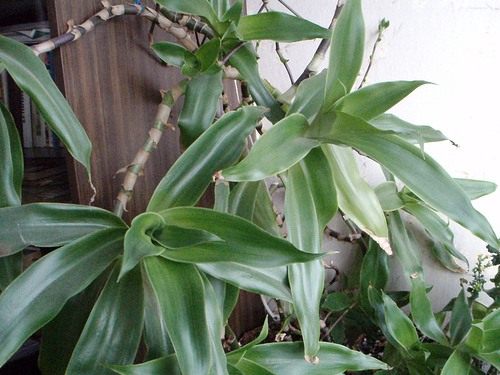

<>
I must say that callisia is far from a panacea, and a rather significant part of its action is based on the patient's faith in healing, but on the other hand, mild stimulation of the immune system and endocrine glands, which gives a golden mustache, are really useful for a number of diseases, mainly inflammatory nature.
You can also use a tincture of shoots, it not only disinfects wounds, but also rubbing sore spots with osteochondrosis, rheumatism, sciatica. To prepare a tincture for external use, a branch of a golden mustache with a length of 12 internodes (several segments of the same total length are possible) are infused in 0.5 liters of vodka for 10 days in a dark place. This tincture is used for compresses, rubbing. However, treatment with calizia is not devoid of features and contraindications. You cannot start treatment with calizia without consulting an experienced herbalist, since the dosage and dosage regimen are different for each disease. One of the complications of exceeding the dose or taking too long is damage to the vocal cords, a change in the timbre of the voice, and sometimes its loss, and recovery is very difficult. You cannot swallow whole leaves, even well-chewed ones - a large amount of rubber does not allow pieces of a leaf to separate from each other, forming a kind of net. Such a sheet, unsuccessfully located, can clog the exit from the stomach and cause its obstruction with serious consequences.
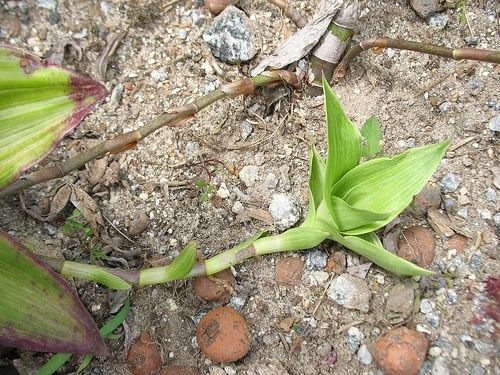

Golden mustache is easy to grow in a room. It reproduces by layering, mustache pieces and ordinary cuttings. The most favorable time for breeding is March, April, but if necessary, you can reproduce all year round.
How to root the stalk correctly? Cut off the top of the shoot with 2 - 4 nodes (joints) from the mother plant of callisia, remove the lower leaves, shorten the upper ones by a third. Dry the cuttings for 2 - 3 hours, and then plant in pots with a richly moistened soil mixture. Moisten the cuttings and cover with a plastic rooting bag.
A rosette of leaves with a small piece of stem is cut off from a horizontal lateral shoot and placed in a vessel with water. A powerful root system develops within 10 to 15 days. Then a young plant of callisia is planted in a pot with an earthen mixture and watered abundantly.
Young plants of fragrant callis are transplanted annually, and adults once every two to three years. It is better to transplant in spring or autumn. The substrate for planting is prepared from a mixture of compost soil, leaf and sand, taken in equal amounts. The acidity index should be in the range of pH 5-5.5. Good drainage is required at the bottom of the container.
When breeding kalizia, it must be borne in mind that it loves light, but does not tolerate direct sunlight, especially hot evening ones. In this case, the plant becomes discolored and curled, whiskers cease to form. Calizia transferred to the shade recovers quickly. Winter temperature should be in the range of 16-18 ° C, otherwise the plants stretch strongly, reducing the amount of active substances. In summer, the golden mustache can be taken outside in a shady place.
Diseases and pests - thrips and red spider mites. At the first signs of damage, the plant of fragrant callis should be sprayed with a systemic insecticide and covered for 1 - 2 days with a plastic bag. The best preventive measures are daily spraying and maintaining the necessary air humidity.
Unhealthy look
A flower kept in unsuitable conditions will certainly react to this.
Symptoms for which you need to take action:
- Yellow leaves
- Withering
- Yellow spots
- The presence of insects in the soil
- The presence of insects on the plant
During periods of low temperatures, abundant watering leads to yellowing and leaf fall. In this case, it is necessary:
- Remove all fallen leaves
- Stop watering
- Give a lot of light
- Provide ventilation
- Loosen the soil
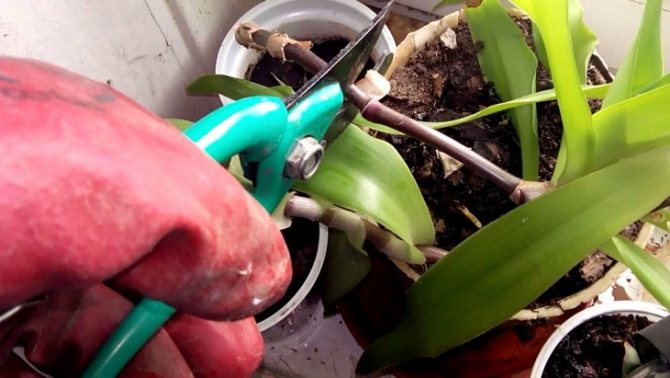

Mustache trimming
In summer, the danger lies in dry soil and dry air: the leaves wilt or turn yellow.
Urgent watering and irrigation under the shower can put the flower in order, if the case is not very neglected. To retain moisture in the soil when planting in a soil mixture, it is advisable to add vermiculite.
Bright, direct sun can leave yellow burn spots on the leaves. In this case, it is necessary to hide the flower from the scorching rays of the sun and treat it with a biostimulant such as HB-101.
The enemies of the golden mustache are thrips and red spider mites. If any unwanted insects appear, the plant must be treated with one of the following preparations:
- Spark
- Actellic
- Fufanon
- Aktara
The best cure for all misfortunes is prevention. Keeping a flower in favorable conditions for it gives the plant immunity.
Expert opinion
Yulia Yurievna
I have a large garden and vegetable garden, several greenhouses. I love modern methods of plant cultivation and soil mulching, I share my experience.
Ask a Question
Getting rid of pests such as spider mites is quite difficult. The problem is that their eggs are difficult to kill, and you will have to carry out several repeated treatments in order to completely remove the ticks. It is necessary either to use a drug with a cumulative effect, or to clearly fall into the gap when the young individuals have already emerged from the eggs, but did not have time to reproduce. It is impossible to calculate this period; systematic processing will have to be carried out. A characteristic feature of the pest is drying and falling foliage. On the aerial part, red or yellow bodies of ticks, as well as a thin cobweb, are noticeable. You can start the treatment by bathing the plant in the shower. During the procedure, keep the pot tilted on the floor so that water does not flow into it. Otherwise, rhizome decay may begin. Next, you can try a remedy made from laundry soap and ash. If the described measures did not help, then you need to apply a specific drug. For example, Aktellik. But, it should be noted that this is a very toxic drug. It is necessary to apply protective measures when using the specified means. Fitoverm can be recommended from the products that are more gentle for your pets. Since it is a biological product, it is much less toxic. But, it is still worth using protective equipment and not treating a room or other closed place.
The drug Neoron is good in that it destroys not only adults, but also partially damages the larvae. In this case, two treatments are sufficient.
How to grow a golden mustache and how to care for it
Growing a golden mustache at home won't be a hassle. It is necessary to create all the optimal conditions under which the plant will be comfortable. A ceramic pot with a diameter of at least thirty centimeters or a wide ceramic vase is suitable for planting.
They are grown not only in pots, but also in a greenhouse, in the country, and even under a film. To do this, you need to use lateral horizontal shoots, which are rooted on the stem in the soil. The main stem must be tied to a support, and the shoots from it are bent to the soil and ground is poured on them. As soon as the shoots take root, they are cut off for transplantation to another location.
Heated greenhouses are equipped with “climate control” or simple air conditioning systems in combination with special fountains to humidify the air in the summer heat. In addition, it is recommended to spray the entire plant with clean water - thawed from the refrigerator or freezer, but not tap water, containing chlorine, phenol and other harmful chemicals.
Proper care of a golden mustache at home provides for daily watering in the spring and summer, but without waterlogging the soil, and less often in autumn and winter - two or three times a week. The soil in the pot must be moistened to the ground. To prevent the jet from eroding the soil, it is better to use a watering can with a fine strainer or a teapot. An hour after watering, the water must be drained from the pallet, and the pallet and the bottom of the pot must be wiped dry so that mold does not appear.
Origin
Today there are 12 known plant species that can be found in the rainforests of the American continent.
The plant was discovered relatively late - in the 19th century, then it was brought to Europe, where the golden mustache immediately gained popularity. Currently, the fashion for growing the house of the Golden Mustache is returning, in connection with the discovery of a number of medicinal properties of callisia.


Homeland of the plant
Flowering features
At home, a golden mustache blooms very rarely. However, during this period, the culture looks very beautiful. A shoot appears on the plant, at the end of which a panicle of white buds is formed. Flowering and its frequency depend on the microclimate in which the plant develops. Abundant flowering can only be observed in a warm room.
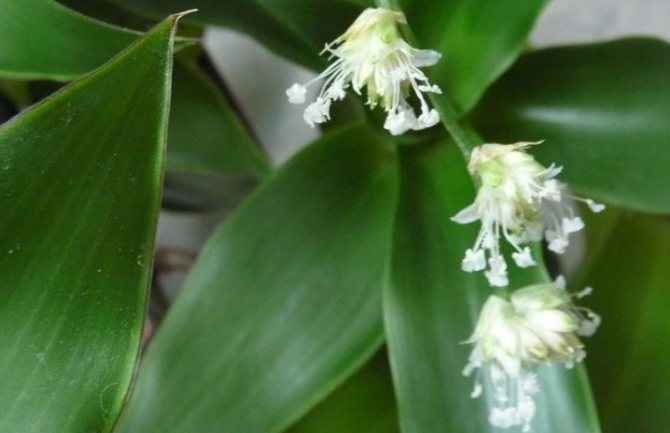

In order for the culture to have more flowers, in the flowering phase, the florist is recommended to independently remove faded specimens.
About the reproduction and rejuvenation of the plant
Gradually, at the base, the shoots begin to bare, lose leaves. Do not overdo adult plants, but use for medicinal purposes. Callisia is usually not transplanted, but rejuvenated. To do this, cut off the top or rosettes that have grown at the ends of the shoots, and put them in a container with water. They give roots very quickly. But do not rush to send them to the ground, wait another week or two, during which time the root system will develop well. It happens that a rosette on a large mustache itself stretches to the soil, and then takes root next to an adult plant. Then it can be transplanted into another container. Pour a drainage layer into the prepared pot, and then the substrate. Prepare it from turf, humus and sand. And everything is taken in equal shares. Another option for the substrate: sod and deciduous soil, sand, humus, peat. You can add a tablespoon of eggshell ground on a coffee grinder to this mixture. Provided that there is no excess salt in the water for irrigation. Be sure to moisten the soil well after planting. By the way, a golden mustache looks more decorative if you send 2 or three cuttings to one pot. Experience shows that plants that have developed from rosettes give more whiskers than those that have grown from the apical part. Rejuvenation is desirable in spring or autumn.
Golden mustache - care
It is not difficult to care for this plant.
Growing medium: home conditions, greenhouse or garden. Humidity level: moderate. Aroma: is present.
Description: slow growing perennial with 15-25 centimeter waxy foliage, alternating. The bases of the leaves are very close and overlap each other, which gives the impression that it is all one rosette of foliage. Creeping stems grow on the surface of the ground or upward if supported. If the climate is mild, then the golden mustache is perfect as a plant covering an empty area. This perennial is often mistaken for a weed. In height, the golden mustache grows up to 30 cm, and in width it grows by 60-120 cm.
Foliage: has a slightly purple tint on the inside, and on the outside, this color appears in bright light.
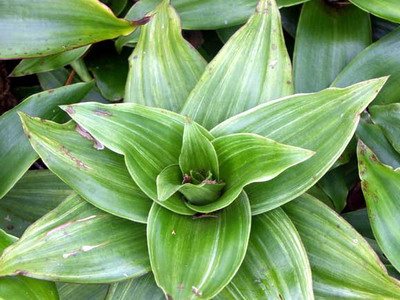

Bloom: in the spring. The golden mustache has a different flowering frequency: it all depends on the climate of your region. The flowers of the plant are formed into groups and have a white tint. They often appear in three at the tops of the stems. The most abundant flowering is observed in warm subtropical climates.
Temperature range: when grown indoors, it is desirable that the temperature does not drop below 0 degrees. With moderate watering, the golden mustache tolerates dry, hot weather.
Lighting: partial shade or shade. If you want the foliage of the flower to have a purple hue, then place it in a place where there is full sunlight. In bright light, the flower grows on the ground, and if the location is shady, then it usually grows upward.
The soil: a golden mustache, which is easy to maintain, thrives best in well-drained soil. Add sand or perlite to ensure good drainage. Loam is perfect as a soil.
Fertilizers: For effective flowering and faster growth, regularly apply organic fertilizers to the soil. If you buy top dressing, then make sure that they contain nitrogen, phosphorus and potassium.
Watering: the soil should be moist, but not soggy. The most important thing is not to water too much, and also to prevent the plant from being in the water for a long time. It is best to water the flower in the morning.


The flowering of a golden mustache in a natural environment in the photo
Reproduction: carried out by planting seeds or dividing. If you choose to reproduce golden whiskers from seeds, collect the seeds and store them in an envelope in a cool, dry place until planting.
When a flower is multiplied by division, it is necessary to take several shoots, cut off the lower leaves and leave 3-4 leaves at the top. Plant in moist soil, and the location should be sunny, but the rays should be indirect.
Landing: rooted plants must be planted 5-7 cm deeper than any other flowers. In order not to be mistaken, plant a golden mustache within 2 cm of the first leaves that appear. The fact is that this plant has more roots along the entire length of the stem, and if you plant it deeper, then it will be stronger and healthier. Golden mustache, which will be difficult to transplant, is best planted immediately in a large, deep container. But if you still decide to transplant the plant, then this should be done in the spring.
Pests: the appearance of mealy worms, spider mites and plant aphids is possible.
What does a golden mustache houseplant look like: photo and description
The indoor plant golden mustache belongs to the commeline family, the genus Callisium. There are 12 species in the genus that grow in the tropics of Central and South America and Mexico. In culture, only one species is best known, which is called the golden mustache.
What does a golden mustache look like in the wild? This creeping grass up to 2 m long "crawls" along the mountain slopes and clearings, rooting in the nodes. It has been cultivated in indoor floriculture for over 100 years.In the 21st century, they began to be planted in winter gardens in combination with other ornamental or medicinal plants such as palm, tea rose, lemongrass, aloe, Kalanchoe, etc.
According to the description, the indoor golden mustache is not much different from the wild one. This culture got its name from the presence of long shoots that extend from the axils of the leaves, like the "whiskers" of strawberries and also take root. The length of these "whiskers" is up to 1 meter, they are naked, reddish-brown with long internodes and small rosettes of leaves at the ends (it is usually believed that only shoots no shorter than 9 internodes are suitable for treatment). Large, up to 30 cm, almost linear alternate leaves, covering the stem, develop only after rooting. When a sheet breaks, thin threads of rubber stretch between its parts. The stem of this plant, although long, is not able to stand upright, so it needs support in the apartment.
With good care at home, a golden mustache sometimes blooms. Small flowers - less than 1 centimeter in diameter - are collected in paniculate inflorescences. Flowers emerge from the axils of the leaves and are collected in paired, hanging clusters on small peduncles.
As you can see in the photo, in a houseplant with a golden mustache, each flower has three white, pink or blue petals:
Despite the fact that the inflorescences themselves are inconspicuous, they attract attention with a strong pleasant smell, similar to the smell of hyacinth.
Fertilization
The most effective fertilizers for golden whiskers are organic fertilizers. During transplantation, humus or peat, which is the main source of nitrogen, must be added to the substrate. An alternative source of this element is ammonium nitrate, which is used during irrigation once every two weeks.
The plant also needs potassium and phosphorus. To prepare the nutrient solution, you need to take one and a half teaspoon of superphosphate, as well as half the potassium salt. These ingredients dissolve in 5 liters of water. It is necessary to feed the golden mustache during the entire vegetative period 2 times a month. Watering is carried out at the very root. With the arrival of winter, the golden mustache does not need feeding.
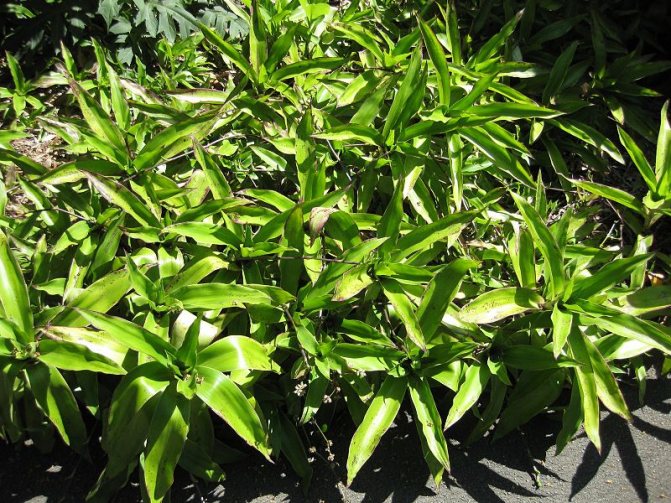

Why is it grown
Calissia was originally introduced into cultivation many years ago as a plant with beautiful emerald leaves. Thanks to the mustache and rosettes, it was used as an ampelous plant.
Only decades later, after many studies, its healing properties were evaluated. This plant contains a lot of useful trace elements and minerals. Golden mustache is also appreciated as a good natural biostimulator that increases immunity, stimulates metabolic processes in the body.
It is necessary to prepare medicinal tinctures and decoctions when the shoot turns brown.
While watching the video, you will learn about the cultivation of a golden mustache.
A real pharmacy on the windowsill can become a golden mustache. Of the many indoor plants, it definitely deserves a place in the home collection.
Houseplants
Golden mustache (Callisia fragrans) - indoor flower
Content
Golden mustache - care
Plant type: perennial.
Homeland: Mexico.
Plant appearance
The flower is quite large and can grow up to one hundred centimeters in height, however, it grows very slowly and usually reaches about forty centimeters at home. If there are supports, then the shoots creep up, if they are not, they grow along the ground.
Over time, tubercles appear on the trunk, which then turn into shoots, consisting of separate "joints" ending in rosettes of leaves.
Leaves dense and fleshy, plant hairs are visible at the break
, thanks to which the flower is called "Venus hair", "living hair".
With proper care, the golden mustache blooms in small small flowers with a pleasant smell, similar to the smell of lily of the valley flowers.
Location
Like most plants native to rainforests, Golden Whisker prefers diffused, bright lighting, but without direct contact with sunlight.The plant pot should be placed near windows on the east or west side. Installation on southern windowsills is allowed, with the obligatory shading of the flower at midday.
Read also: How to make a candlestick from a jar with your own hands
For the summer period, callisia can be taken out into the fresh air in the garden or on the balcony, placing it in a lace shade. The flower does not like polluted air, so it has no place in the kitchen or in the smoker's room.
Pests, diseases
Callisia is an unpretentious plant, but it can also suffer from improper care. Blanching and yellowing of the leaves, with drying out of the tips, indicates sunburn or lack of nutrition.
Excessive moisture in the substrate is indicated by the yellowing and decaying lower leaves of the golden mustache. A flower can be saved by transplanting into a new soil, with the removal of rotten parts of the plant. The wounds on the stem are sprinkled with crushed charcoal.
A spider mite can parasitize on a plant. The spread of the pest is facilitated by the dry air in the room. You can exterminate the pest with a soapy solution, washing all parts of the plant. In severe cases, the golden mustache is sprayed with Actellik (1 ml per liter of water).
Important! After treatment with a chemical preparation, it is impossible to cut off shoots for treatment within 3 weeks!
Four-legged pets (cats and dogs) are not averse to feasting on callisia, eating leaves from a flower. It is better to place a pot with a plant in places inaccessible to animals.
Application
For medicinal purposes, use a golden whisker rosette from shoots with a length of 12 knots. Fresh callisia greens are crushed, squeezed and squeezed out of the juice. They do not store it, rub the skin with fresh juice in case of bruises, burns, joint pains. Apply compresses with juice for skin cancer.
Golden mustache juice mixed with baby cream or petroleum jelly (1 to 3) will help heal sciatica, arthritis, frostbite.
Callisia tincture
A decoction of callisia helps with diabetes, allergies, removes toxins and toxins from the body. To make the potion, the leaves (basic, not from sockets) of a golden mustache, 20 cm long, are boiled for 3 minutes (for 1 part of plant material, 3 parts of boiling water). The broth is poured into a thermos and left for 24 hours. You need to take the medicine in 1 tbsp. spoon three times a day, half an hour before meals.
After squeezing the juice from the leaves, the remaining raw materials do not need to be thrown away. The cake can be poured with any refined oil and placed in a dark, cool place for 3 weeks. The finished medicine is filtered, stored in the refrigerator. Used for skin diseases, headaches (smeared with whiskey).
Read also: Tomato variety bovine forehead
Alcohol tincture of the golden mustache helps to improve the work of digestion, tones up. The shoot of callisia is crushed, placed tightly in a jar and poured with vodka. The medicine is prepared for 14 days in a dark and cool place. Take the tincture before meals, 0.5 - 1 tbsp. spoon.
Watch also a video on the topic:
A golden mustache is held in high esteem at home along with aloe. My mother raises them. And the tincture of the golden mustache is always in a conspicuous place, it is our first assistant in different situations.
My parents only use his tincture and save themselves. Sore joints will rub, it becomes easier. I chew leaves instead of immunomodulators during epidemics. I don't know what helps, but usually I stay healthy.
There used to be a golden mustache at home, but now it is not. I don't even remember if it was lost or given to someone. You need to plant this useful indoor plant. I used the tincture.
The golden mustache grows in my grandmother and she often uses it for joint pain.
Previously, I had a beautiful golden mustache, but now I was completely bent, perhaps due to the move, I want to revive it somehow, I took note of the recommendations from the article, I will try.
I didn’t know that when planting, the roots should be so large, but if they are smaller, they will not take root?
It will take root, but good roots grown in water allow you to immediately get a strong, fast-growing plant. With small roots, things will go slower.If you need high-quality medicinal raw materials, this is important, if the plant is for the interior, you can take your time.
Once she grew a golden mustache, but gave it to her mother-in-law. Thanks for the helpful information, I should do it again.
What a useful plant, it turns out, you can plant at home, nature never ceases to amaze!
That's for sure. Golden mustache - pharmacy on the windowsill.
I also have a golden mustache. Just recently I cut off the mustache and put the tincture with them. I will treat my husband's joints and lower blood sugar levels.
A month ago, we put everything that we saved from the coming cat. So he gets a piece to chew, tramp.
Well, you intrigued me! I didn't know about such a plant, I also wanted to have it since it is so useful.
Olga, I'm glad that I am interested. A lot of literature has now been published about the golden mustache, not to mention information on the Internet.
I've heard a lot of good things about Golden Mustache. Dad even bought a book about him at one time. And now the cream with the Golden Mustache helps mom well.
Ksenia, we also have a book. They tried my cream, but their own tincture helps them better, the concentration is higher.
We have this useful plant. It is unpretentious, does not require much attention to itself and reproduces in all possible ways.
That's for sure, even in neighboring pots it strives to take root.
A useful golden mustache, my grandmother also told about it.
We used to have such a "mustache", my mother even made a tincture, then rubbed her legs with it, now everything is somehow forgotten, it's easier to buy at the pharmacy.
Easier, especially since you can buy it at a pharmacy. But the parents tried it, it helps worse. Probably, the concentration is different.
At one time we had such a plant at home, quite unpretentious and easy to care for, as it seemed to me. Thanks for the helpful information, it will come in handy!
I also had no problems with him, a healthy one with numerous mustaches even looks decorative.
Yes, I have a Golden Mustache. And I made the tincture!
Thanks for all the tips, come in handy!
A very beautiful plant, I did not know that it blooms.
It was interesting to find out about the cats. Didn't know they loved him. It's true, the animal knows a lot about medicinal plants)
Kitties are the best inspectors. They won't eat bad things.
We have a lot of such flowerpots at work. There is in every office. I didn’t know that they have healing properties.
Yes, Callisia is very decorative, but also useful.
The golden mustache is a very unpretentious plant. It has so much strength that it will not be difficult to grow it, and the benefits of the plant are simply undeniable.
Much has been written about this amazing plant, my mother even had a book with a large number of medicinal recipes based on a golden mustache.
A very useful plant for humans. Now many people grow it and make tinctures and various preparations from the golden mustache.
Yes, it is better to have a living first aid kit on the windowsill than to pay for chemistry from the pharmacy. I'll try to get myself such a plant.
We didn't think that this plant could be grown at home. We always thought that it was not for our region. Now let's try.
I have a Golden Mustache, a fairly unpretentious plant and multiplies easily. I add the juice of this plant to masks and face creams.
I also have a golden mustache. I insist on vodka, and then I rub my back. It helps me.
I heard about the benefits of the Golden Mustache, but did not think that you can grow it yourself. If this plant is unpretentious, then, perhaps, in my house it may well take root. Thanks for the advice!
She used to grow a golden mustache. But then I gave it to my mother in the village, where indoor plants grow much better. If necessary, I pinch off myself.
Golden mustache, has been growing with us for a long time, we make tincture, rub the sore joints.
I have been growing a golden mustache for several years, but it never bloomed with me, maybe I was just unlucky.
At one time, my parents had a golden mustache, my mother made a medicinal tincture from it.
The soil
For the plant, choose wide and deep pots with several drainage holes in the bottom.At the bottom, it is necessary to pour drainage, in a layer of 1 - 1.5 cm, consisting of a mixture of expanded clay, small pebbles and pieces of eggshell.
For a golden mustache, loose and fertile soil is suitable, consisting of leafy humus (forest soil taken from under an oak or linden), river sand and oily humus from plant residues or manure.
Before planting the plant, the soil mixture is steamed in the oven or spilled with a hot raspberry solution of potassium permanganate.
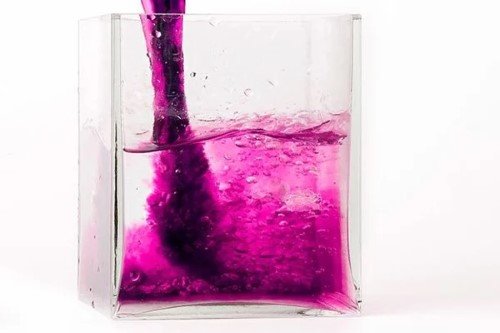

Potassium permanganate solution
The golden mustache needs warmth, the temperature at the level of +22 +25 degrees is comfortable for him. It can be cooler in winter, but the temperature cannot be allowed to drop to +14 - the plant can get sick. Callisia cannot stand drafts.
It is necessary to water the flower often, daily in summer, in winter - at least twice a week. Care must be taken to ensure that the drainage holes of the pot are not clogged and that excess moisture can flow out unhindered. In swampy soil, the roots of callisia can rot. Water for watering plants is defended and heated to room temperature.
The golden mustache is demanding on the humidity of the air, it is useful to spray it with warm water several times a week. Loves a warm shower flower that imitates a tropical rainstorm.
In the spring-summer period, during the active growing season of the flower, top dressing is applied to the soil. Use ready-made mineral compositions for indoor plants or mix fertilizers on their own. For example:
- in 10 liters of water dissolve superphosphate 2 tsp;
- ammonium nitrate 2.5 tsp;
- potassium salt 1 tsp;
- ferric chloride half a teaspoon.
Top dressing is applied twice a month, watering the flower on wet soil, and spending at least 1 liter of solution for each adult plant. The flower responds well to foliar dressings on the leaf. In this case, the concentration of the nutrient solution is halved.
The golden mustache is grown by letting the flexible stem curl along the support or by tying it with ropes to hooks on the wall.
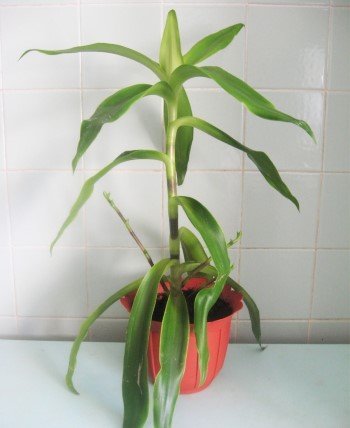

Description
Herbaceous perennial evergreen. The stem of callisia is creeping, up to 200 cm in length, in conditions of home cultivation, it needs a support or a garter. Lateral shoots, growing from the axils of the leaves, like strawberry whiskers, stretch in different directions, looking for a convenient rooting place. Shoots can reach lengths of up to 100 cm, they are bare, only at the tips they have a small rosette of leaves.
The leaves of the Golden Mustache are narrow, up to 30 cm long, alternate. The flowering of the plant, when grown indoors, is rare. Flowers, endowed with a strong and pleasant aroma, are formed in the leaf axils. Their petals are colored pink, white or blue.
You can get acquainted with the appearance of the flower by the presented photos of the golden mustache.
Widely used in folk medicine for the treatment of atherosclerosis, metabolic disorders and other ailments, the plant is not recognized by official medicine. Currently, the properties of callisia are being investigated, but it is too early to wait for the conclusions of scientists.
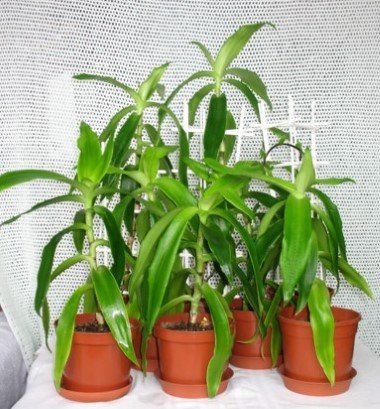

Appearance
Are there any difficulties in growing?
Callisia usually grows very well and provides many benefits without causing a hassle. The main thing is not to forget to water it, spray it if there is dry air in the room. If ugly spots appear on the leaves, it is likely that the "home ginseng" was burned by the burning sun's rays. From the intense sun in hot weather, it must be shaded or rearranged to another place. And if the tips of large sheet plates dry, turn brown, then this is a clear sign that the climate in the apartment is too dry.
If you notice decay of one or more of the lower leaves, then this can happen for two reasons: in the winter months - hypothermia occurs at night or watering is excessive.
Thrips and spider mites can harm the "living hair".
Many medicinal potions can be prepared from parts of the plant. Pieces of leaves (3 cm each) are useful to chew when coughing or stomach ailments. And with juice you can lubricate wounds, scratches, calluses.While in the room, the golden mustache releases phytoncides that have antiseptic properties.
Golden mustache propagates by cuttings, branches (whiskers) throughout the year. The most favorable time for breeding is March, April, but if necessary, you can reproduce all year round.
2. In case of diabetes mellitus, prepare such an infusion. And chop a leaf of a plant with a length of at least 15-20 cm with your fingers and pour 1 liter of boiling water. Wrap and let it brew for a day, strain. Take the nastya of the golden mustache in a warm form, 50 ml 3-4 times a day, 40 minutes before meals.
3. In case of bronchial asthma, take the following tincture: pour 35-50 joints of 1.5 liters of vodka. Insist 9 days, drain. A good quality tincture should have a lilac color. Take 1 dessert spoon 3 times a day 40 minutes before meals. A prerequisite is not to drink anything or eat anything.
4. In case of inflammation of the mucous membrane of the mouth and gums, chew the leaves (rosette of leaves, not a mustache). Swallow the juice and spit out the cake. Store the leaves in the refrigerator.
5. With leukemia. Mix 1 part of the crushed golden mustache plant with 1 part (by volume) buckwheat honey and 2 parts of Cahors. Insist 40 days. Take 1 tbsp. spoon 3 times a day 40 minutes before meals. Drink 0.5 cups of decoction of horse chestnut flowers (1 tablespoon of flowers per 1 liter of water.
In whatever form you use the golden mustache (infusion, tincture, balm, juice, etc.), in the first 2-3 days of admission, you need to reduce the dose and the amount by taking at least half in order to find out how your body will react to the new medicine. If there are no side effects, gradually increase the dose to the rate indicated in the prescription.
6. For pain in the stomach and intestines, chew the stem of the plant in the morning and evening before meals. Swallow only juice, spit out the cake.
7. In case of stomach ulcers, chew one joint of the golden mustache at night, spit out the cake.
8. With angina pectoris. Pass the trunk and leaves of the plant through a meat grinder, squeeze out the juice, mix with honey (1: 1) and take this mixture 1 tablespoon 2 times a day, morning and evening.
9. In case of mastopathy, make compresses: from leaves or tincture (13-15 joints per 0.5 liters of vodka). This tincture can be taken orally, 1 tablespoon one hour before meals.
10. For polyps of the large intestine, take the following tincture: pour 0.5 liters of vodka on 15-17 joints. Insist in a dark and warm place for 12 days. Take 1 dec. spoon 1 time per day 30-40 minutes before meals.
11. With glaucoma. Tear off one or half a leaf (if large) of a golden mustache, squeeze the juice into a spoon and add 2 drops of fresh juice with a pipette in both eyes.
12. For bumps on the fingers, apply compresses. First apply a sheet, then polyethylene and cotton wool. Secure with a bandage. Change the compress every 12 hours After a few weeks, the lump will disappear.
Material taken from the magazine "Be healthy".
You can ask your question or leave a review
Golden mustache is the popular name given to the flower for the presence of side curving shoots, similar to mustaches. The scientific name of the plant is Callisia fragrans. The genus Callisia belongs to the Kommelinov family.

